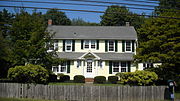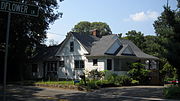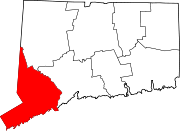Nichols, Connecticut



Nichols, a historic village in southeastern Trumbull on the Gold Coast (Connecticut) of Fairfield County, was named after the family who maintained a large farm in its center for almost 300 years.[1][2] The Nichols Farms Historic District, which encompasses part of the village, is listed on the National Register of Historic Places.
Originally home to the Golden Hill Paugussett Indian Nation, the Nichols area was colonized by the English during the Great Migration of the 1630s as a part of the coastal settlement of Stratford, and used primarily for agriculture and animal husbandry. The first settlements in Nichols were doubtless made soon after the settlement of the mother-town of Stratford in 1639.[3]
In the mid-nineteenth century, manufacturing of carriages and saddle trees was established. By the early twentieth century, after the mass production of the automobile and extension of commuting routes, Nichols became an affluent suburb for the nearby cities of Bridgeport, Stratford and Shelton. The construction of the Merritt Parkway through Nichols Center in 1939 and the closing of local factories, turned the village into a bedroom community for lower Fairfield County.
Golden Hill Paugussett Indian Nation
The Golden Hill Paugussett Indian Nation is a Connecticut state-recognized tribe, descendants of the Paugussett (also Paugusset) Nation of Native Americans, who occupied much of western Connecticut prior to the arrival of Europeans.[4][5] While state-recognized, they have been denied federal recognition.[6] The tribe lives in Colchester, Connecticut, where it has a 106-acre (0.43 km2) reservation,[7] and also has a 1⁄4-acre (0.0010 km2)[8] reservation in Nichols, which is considered to be the oldest continuing reservation in Connecticut and the smallest in the US.
History
As the first volume of Stratford land records were destroyed in 1650, early records of English settlement are not available. In 1661, the Stratford selectmen voted to allow all inhabitants the liberty of taking up a whole division of land anywhere they could find fit planting ground, as long as it was not within two miles (3 km) of the town meeting house. They were prohibited from making it their dwelling place without consent. Elder Phillip Groves, Captain William Curtiss and Lt. Joseph Judson, early landowners in Nichols, were named to a committee to lay out the land as they saw fit.[9] Before 1661, people were free to take up planting grounds anywhere within the township. The common land in Nichols Farms was divided and granted to individuals beginning in 1670 as a part of the three-mile or woods division and continued up to 1800.[10]

Agriculture
Mischa Hill is located in the geographic center of Nichols. The area was first called Misha Hill or Lt. Joseph Judson's Farm in the land records. It was the first area within Trumbull to be farmed and settled due to its fertile soils, spring-fed ponds, natural meadows and its close proximity to the main village, less than three miles away.
The first landowners included the following: William Beardsley, Richard Booth, Zachariah Bostick, John Brinsmaid, John Curtiss, Benjamin Curtiss, Joseph Curtiss, Captain William Curtiss, Ebenezer Curtiss, Zachariah Curtiss, Joseph Fairchild, Elder Philip Groves, Joseph Hawley (Captain), Samuel Hawley, Ephraim Hawley, John Hurd, Lt. Joseph Judson, Jeremiah Judson, Isaac Judson, Isaac Nichols, Caleb Nichols, Abraham Nichols, Samuel Uffoot and Reverend Zachariah Walker.[11]
Lt. Joseph Judson, Sgt. Jeremiah Judson, and Joseph Curtiss established farms on Mischa Hill before 1658, the year they were all elected as freeman (Colonial) by the legislature of the Connecticut Colony. To be elected as a freeman, at this time, an individual had to own real property in his own name.[12][13]
Religious rift
In the 1660s, Lt. Joseph Judson began a disagreement with the majority of elders in town as he and others tried to introduce the half way covenant. In 1671, Judson obtained permission from Governor John Winthrop, Jr. to remove with other families and settle a new town called Woodbury. Judson and the other Woodbury founders, either sold, gifted or abandoned their farms in Nichols.[14]
In 1688, John Curtiss removed to Woodbury, giving his entire farm on Mischa Hill to his son Benjamin, who had married Joseph Judson's daughter.[15] Shortly after Judson and the others had abandoned their farms in Nichols to remove to Woodbury in 1673, the area was commonly referred to as Old Farm, Old Farms and Judson's Farm's in the Stratford land records.
Abraham Nichols
Abraham Nichols is credited, by some, with being the first Englishman to settle in Trumbull around 1690 or 1700, depending on the source. It has been said that others soon followed him into the wilderness to; "establish mills, churches, and schools". Nichols landholdings were said to total as much as 3,000 acres (12 km2).[16] However, none of these claims can be substantiated by the public land records.
According to Walter Nicholls, who wrote the History of the Nichols family in 1909, Abraham did not accompany his father to Woodbury in 1673, but remained in Trumbull to oversee the plantation. Since Abraham was only eleven in 1673 (born 1662), it is likely that he removed to Woodbury with his family, and later returned to Trumbull between 1696 and 1700 as an adult.[17] According to the public land records, Nichols owned 285 acres (1.15 km2) of land, purchased between 1696 and 1700, of which 55 acres (0.22 km2) remains as open space today.
The last Nichols to reside on the farm was Florence, who married George Woods in 1903. Soon after their deaths in 1973 and 1972 respectively, the property was donated to the Nichols Methodist Church, as the Florence and George Woods had bequeathed. The Town of Trumbull purchased the land from the church in 1974. This tract was then known as the Woods Estate, and is now the home of the Trumbull Historical Society.[18]
Development
Nichols is named for the family that maintained a large farm in its geographic center for almost three hundred years. In May 1725, the northwest farmers of Stratford petitioned the Colony of Connecticut to form their own village. The farmers wished to call their new Parish Nichol's Farms. The legislature approved their new village in October 1725, but named the new parish Unity. Unity became a part of North Stratford in 1744 when it merged with the parish of Long Hill, Trumbull, which had been founded in 1740. When it incorporated in 1797, the Nichols village became a school and taxing district as a part of the Town of Trumbull.[19]
Nichols Green
The Nichols Green or N.I.A. Green, is owned and maintained by a private trust called the Nichols Improvement Association, established in 1889 to beautify and improve the village.
- A memorial to those residents who fought in World Wars I and II is located on the south end of the green.
- An 80' tall pine flagpole brought through the Panama Canal from Washington was erected on the green in 1932. This pine pole replaced an earlier 115' chestnut flagpole erected on July 4, 1892 that carried a 25' by 15' flag and was believed by some to be the highest flag flown in the state at the time.
- Another landmark near the green is the Bunny Fountain. The fountain was a gift from the Peet family to the citizens of Nichols in 1895. Originally installed at the intersection of Huntington Turnpike and Shelton Road, it was moved to the Turnpike and Unity Road in 1931. In the spring of 1971, it was restored and moved to its present location. It was restored again in 1992.
- An old grinding stone from the 1826 Fairchild (Paper) Mill is placed at the south end of the green. The mill was located at the Falls of the Pequonnock River beginning in 1674; the area is now called Fairchild Park and marks the Town boundary with Bridgeport.[20]
- A piece of the original 1940 Merritt Parkway bridge, which was built over Huntington Turnpike, is installed on the green. The concrete ornament is a likeness of the town of Trumbull official seal. The bridge was demolished in 1979 when the interchange was updated.
Pinewood Lake
Then called Pine Brook Country Club, Pinewood Lake is notable for having served as the summer rehearsal headquarters of the Group Theatre from New York City.[21] Formed in 1931 by Harold Clurman, Cheryl Crawford and Lee Strasberg, the Group Theatre and had a vision of doing socially responsible works that would raise community consciousness. It was composed of actors, directors, playwrights and producers.[22][23] The Group gathered to rehearse in the countryside every summer during the 1930s of the Great Depression. They spent the summer of 1936 at Pinewood Lake. During this time, they produced works by the most important American playwrights. Their emphasis on realistic dramas changed stage and film forever.
Nichols Avenue
The road linking the village of Nichols to Stratford center, three miles (5 km) to the south, was first called the Farm Highway, now called Nichols Avenue or (Route 108). The historic road was laid out or surveyed to the south side of Mischa Hill in Nichols on December 7, 1696. The highway was described as being completed to the south side of Mischa Hill and at Zachariah Curtiss, his land, and at Captain's Farm.
In October 1725, when the Connecticut Colony approved the Parish of Unity, they referred to the Farm Highway as Nickol's Farm's Road.[24] The Nichols Avenue portion of Route 108 in Trumbull is the third-oldest documented highway in Connecticut, after the Mohegan Road, Connecticut Route 32 in Norwich (1670) and the King's Highway, or Boston Post Road Route 1 (1673).[25]
Merritt Parkway
The Merritt Parkway was built directly through the center of Nichols in the late 1930s displacing a residence and the old Nichols Store, which were razed, and the Trinity Church which was moved a few hundred feet to the north. The large 5' by 6' natural stepping stone was the only item saved from the old Nichols Store and was relocated to the front of the Ephraim Hawley House. In 1979, the original Huntington Turnpike Overpass was demolished and a new bridge was built in its place when the interchange was updated. When the original 1940 overpass was demolished, the cast-iron grills that resembled a trellis with a grapevine were salvaged restored and placed as decorative items on the replacement Huntington Turnpike Underpass. The new bridge is not listed on the NRHP.[26]
Notable people, past and present
- Dick Allen (b. 1939), American poet and present poet laureate of the state of Connecticut.[27]
- James Beebe (1717–1785), Reverend Unity Parish from 1747 to 1785, Army Preacher in the French and Indian War and patriot.[28]
- Truman Bradley (1826–1900), American Indian from the Schaghticoke tribe.[29]
- Will Geer, (1902–78), actor and folklorist[30]
- Robert Hawley, (1729–1799), Captain local militia during American Revolutionary War.
- Carolyn Hax (b. 1966), writer and columnist for the Washington Post and the author of the advice column "Tell Me About It".[31]
- Joseph Judson (1619-1690), early settler, militia officer and elected official, negotiated Long Hill Purchase from the Paugussett Indians.
- Igor Sikorsky (1889–1972), aviation pioneer and helicopter inventor.[32][33]
Images
-
Zachariah Curtiss Houses c. 1686 and c. 1721
-
Peet barn ca. 1700 (house demolished)
-
Joseph Plumb House ca. 1780
-
Igor Sikorsky home 1928–1934
-
Igor Sikorsky home 1945–1948
-
Igor Sikorsky home 1948–1951
-
Town Seal from 1940 Merritt Parkway Bridge at Huntington Turnpike now demolished
-
Circa 1932 Flag Pole NIA Green
-
Monument to World War Veterans
-
N.I.A. Starkweather House and Peet Fountain view from green
-
Fairchild Mill Grindstone Circa 1826
References
- ^ Census.gov website retrieved 2011-06-26
- ^ The Connecticut Economy Fall 2008
- ^ [1]History of Fairfield County, Connecticut with Illustrations and Biographical Sketches of Its Prominent Men and Pioneers, Hurd, D. Hamilton, J.W. Lewis & Company, Philadelphia, PA, 1881, page 771
- ^ Christopher Reinhart (2002-02-07). "Effect of State Recognition of an Indian Tribe". State of Connecticut. Retrieved 2010-08-06.
Connecticut statutes recognize five tribes: (1) Golden Hill Paugussett, (2) Mashantucket Pequot, (3) Mohegan, (4) Paucatuck Eastern Pequot, and (5) Schaghticoke.
- ^ Brilvitch 2007, pp. 11--12.
- ^ Bureau of Indian Affairs (2004-06-21). "Final Determination Against Federal Acknowledgement of the Golden Hill Paugussett Tribe". Federal Register. United States. pp. 34388–34393. Retrieved 2010-08-06.
- ^ "Aurelius Piper, chief of Connecticut tribe". Associated Press. Boston Globe. 2008-08-06. Retrieved 2010-08-07.
{{cite news}}: Cite has empty unknown parameter:|coauthors=(help) - ^ Eisner, Will (1975). "Politics". Odd Facts. Tempo Star. p. 94. ISBN 978-0-448-13506-9.
- ^ Reverend Samuel Orcutt, A History of the Old Town of Stratford and the City of Bridgeport, Connecticut, 1886, Vol. 1 page 167 [2]
- ^ Orcut (1886), History, Vol. II, p. 1039
- ^ Stratford Land Records, Vol. 2', p. 82
- ^ Orcutt, Vol. II, p. 109
- ^ Colonial Records of Connecticut, May 20, 1658, Vol. 1, p. 315
- ^ William Cothren, History of Ancient Woodbury Connecticut From the First Indian Deed 1659 to 1872, 1872, Vol. 2 p. 916
- ^ Stratford Land Records, Vol. 2, p. 70
- ^ Commemorative biographical record of Fairfield County, Connecticut: containing biographical sketches of prominent and representative citizens, and of many of the early settled families, Higginson Book Co., 1899, p. 38
- ^ Orcutt, Vol. 2 p. 1252
- ^ Trumbull Historical Society website retrieved 2011 03-19
- ^ The Public Records of the Colony of Connecticut, volume 6, p. 568
- ^ Reverend Samuel Orcutt, A History of the Old Town of Stratford and the City of Bridgeport, Connecticut, Fairfield County Historical Society, 1886, Vol II page 1060 [3]
- ^ Don Wilmeth, The Cambridge Guide to American Theatre, p. 21
- ^ The Fervent Years: The Story of the Group Theatre and the Thirties, 1975, p. 184
- ^ A Gambler's Instinct: The Story of Broadway Producer Cheryl Crawford, p. 52
- ^ Colonial Connecticut Records 1636–1776, Vol. 6 p. 568
- ^ Kurumi Connecticut Roads retrieved on 2008-04-11
- ^ Images of America Traveling The Merritt Parkway, Larry Larned, Arcadia Publishing, 1998. p. 102
- ^ "Image ◊ Artist of the Month ◊ Dick Allen". Imagejournal.org. July 23, 2009. Retrieved February 22, 2011.
- ^ Biographical sketches of the graduates of Yale college with annals of the college history, Franklin Bowditch Dexter, Holt, 1896 [4]
- ^ "FR Doc 02-31229". Edocket.access.gpo.gov. Retrieved February 22, 2011.
- ^ "An interview with Will Geer from 'The Waltons'". Acorn-online.com. March 15, 2010. Retrieved February 22, 2011.
- ^ "WEDDINGS; Carolyn H. Hax, N. E. Galifianakis – New York Times". Nytimes.com. June 26, 1994. Retrieved February 22, 2011.
- ^ U.S. patent 1,848,389
- ^ Ikenson page 24
Bibliography
- Trumbull Historical Society, History of Trumbull, Dodrasquicentennial, 1797-1972, 1972
- Reverend Samuel Orcutt, History of the Old Town of Stratford, Connecticut, Fairfield Historical Society, 1886
- Dorothy M. Seely, Tales of Trumbull's Past, Trumbull Historical Society, 1984
External links
- Trumbull, Connecticut
- History of Connecticut
- Populated places established in 1725
- Farms in Connecticut
- Colonial architecture in Connecticut
- Federal architecture in Connecticut
- Greek Revival architecture in Connecticut
- 1725 establishments in Connecticut
- Geography of Fairfield County, Connecticut
- Villages in Connecticut
- Farms on the National Register of Historic Places in Connecticut
- National Register of Historic Places in Fairfield County, Connecticut












